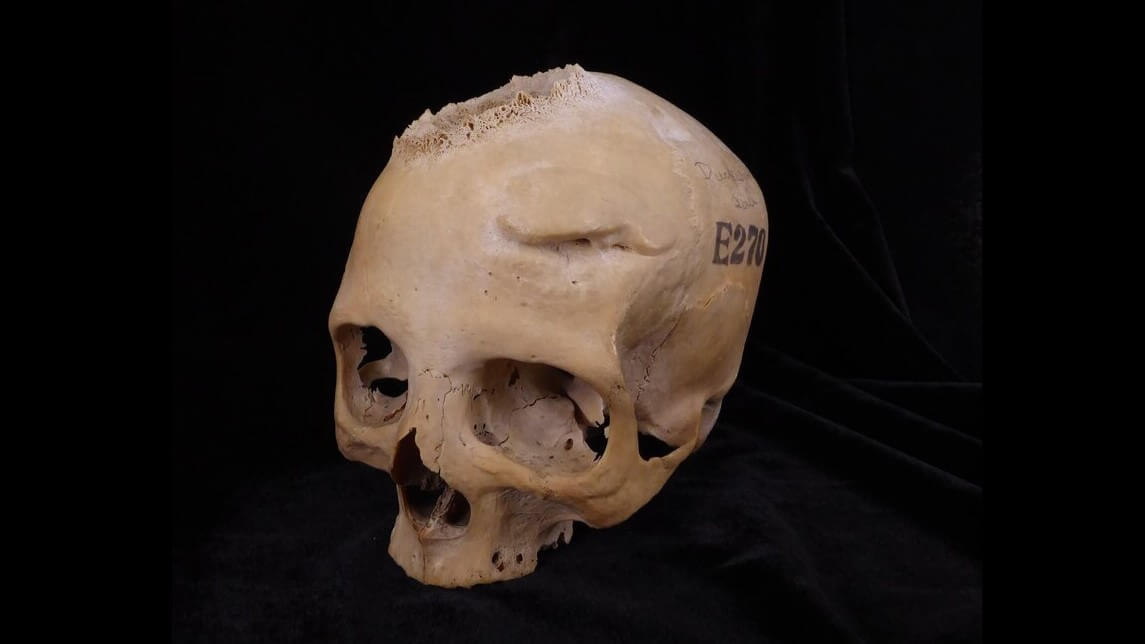
Skull and mandible 236, dating from between 2687 and 2345 BCE, belonged to a male individual aged 30 to 35. (Credit: Tondini, Isidro, Camarós, 2024)
Study also raises new questions about the role of women during combat in ancient Egypt.
The ancient Egyptians are renowned for their remarkable achievements in medicine, architecture, and art. Now, a groundbreaking study is shedding light on their attempts to tackle one of the most formidable medical challenges: cancer. After examining two ancient Egyptian skulls each over 2,000 years old, the international team of researchers says cutmarks were found around cancerous growths on the specimens.
The study, published in Frontiers in Medicine, was led by Prof Edgard Camarós, a paleopathologist at the University of Santiago de Compostela, and Tatiana Tondini, a researcher at the University of Tübingen. They examined two skulls from the University of Cambridge’s Duckworth Collection, one belonging to a male individual aged 30 to 35 (dated between 2687 and 2345 BCE) and the other to a female individual over 50 years old (dated between 663 and 343 BCE).
The researchers discovered that the male skull had a large lesion consistent with excessive tissue destruction, known as a neoplasm, along with around 30 small, round lesions scattered across the skull, indicating the spread of cancerous cells (metastasis). Remarkably, they also found cutmarks around these lesions, likely made with a sharp metal instrument. “When we first observed the cutmarks under the microscope, we could not believe what was in front of us,” Tondini said in a media release.
This discovery suggests that ancient Egyptians performed surgical interventions to treat or explore cancerous growths. “It seems ancient Egyptians performed some kind of surgical intervention related to the presence of cancerous cells, proving that ancient Egyptian medicine was also conducting experimental treatments or medical explorations in relation to cancer,” explained co-author Prof Albert Isidro, a surgical oncologist at the University Hospital Sagrat Cor and an Egyptology specialist.

The female skull also exhibited a large lesion consistent with a cancerous tumor that led to bone destruction. This finding indicates that cancer was a common pathology in the past, despite the increased risk factors in modern times, such as lifestyle, aging populations, and environmental carcinogens.
Interestingly, the female skull also showed two healed lesions from traumatic injuries, one of which appears to have been caused by a close-range attack with a sharp weapon. Such injuries are uncommon in female remains, raising questions about the role of women in ancient Egyptian society. “Was this female individual involved in any kind of warfare activities?” asked Tondini. “If so, we must rethink the role of women in the past and how they took active part in conflicts during antiquity.”
The study also highlights the challenges of working with skeletal remains, which are often incomplete and lack clinical history. “In archaeology we work with a fragmented portion of the past, complicating an accurate approach,” Isidro pointed out.

This groundbreaking research offers a unique perspective on the history of medicine and how ancient societies dealt with complex medical issues like cancer. “This finding is unique evidence of how ancient Egyptian medicine would have tried to deal with or explore cancer more than 4,000 years ago,” said lead author Prof Edgard Camarós. “This is an extraordinary new perspective in our understanding of the history of medicine.”
While the ancient Egyptians were skilled in treating cranial fractures and other injuries, cancer remained a medical frontier for them. As Tondini explained, “We see that although ancient Egyptians were able to deal with complex cranial fractures, cancer was still a medical knowledge frontier.”

The study sets the stage for future research in the field of paleo-oncology, which aims to understand the role of cancer in ancient societies and how they approached this devastating disease. As Camarós concluded, “This study contributes to a changing of perspective and sets an encouraging base for future research on the field of paleo-oncology, but more studies will be needed to untangle how ancient societies dealt with cancer.”









